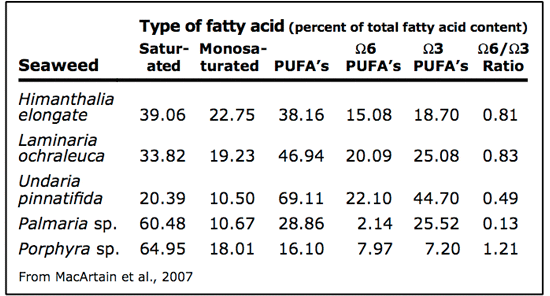Could seaweeds be used in aquaculture feeds? The answer appears to be yes. While terrestrial ingredients have served as the immediate replacements for fish meal in aquaculture feeds, the possible use of seaweeds in the future holds the promise that marine aquaculture could, one day, be sustained without using land, fresh water, or fertiliser.
Presently, there are about 14 million metric tons (15.4 million US tons) of seaweed farmed worldwide compared to about one mmt harvested from the wild. Most seaweed is farmed in Asia where about half is used for human consumption and half for industrial processing into marine colloids (used to make paint and foods smooth) and other products. Extrapolation from Chinese production of a seaweed known as Laminaria, for which the average yield in 2004 was 19.4 mt dry weight per hectare (8.7 US tons per acre) suggests that the world’s present total agricultural out- put of about five billion mt (5.5 billion US tons) could be matched by seaweed production in an area of 2.6 million km² (1.0 million square miles). This is only 0.74 percent of the 349 million km² (135 mil- lion square miles) covered by the world’s oceans.
Of course extrapolations can mislead and any development on this scale will take decades, if not centuries. But the potential and its significance are obvious and they prompt a second question: should this be a priority for future research? Again, the answer appears to be yes.
Seaweeds contain valuable amino acids and fatty acids, including omega-3 and omega-6 polyunsaturated fatty acids, marine oils which are part of the reason why seafood is considered healthful–see the fatty acid table. They also contain minerals, vitamins and anti-oxidants as well as being rich in dietary fiber but low in starchy carbohydrates, thereby providing less glycemic load than ingredients derived from grains.

However, several impediments to utilization in feeds must be overcome before seaweed products can be used, including:
Processing (bio-refining) of seaweed to increase the availability of nutrients In the raw state, seaweed nutrients are protected by indigestible cell walls, or are chemically bound in a way that dimin- ishes their potential nutritional value. Japanese scientists have used fermentation and enzymatic digestion to release and concentrate these nutrients. They have shown that when protoplasts, which contain the bulk of the protein, from the seaweed Porphyra are released from the cells after treatment with a polysaccharide degrading enzyme, their inclusion at only five per cent in feeds for red sea bream led to improved growth and nutrient retention. Significantly, Porphyra is known to contain high levels of taurine, an amino acid that has also been found to stimulate growth of fish when they are fed with land plant-based feeds.
Species selection and breeding of seaweeds for fast growth and high concentrations of the most valuable nutrients. The science of seaweed breeding lags well behind that of terrestrial plants. However, in China, where most of the world’s seaweed is farmed, one variety of Laminaria has undergone 15 generations of selection from 1959 to 1974, and grows faster and contains more iodine compared with the natural population. Advances have also been made in protoplast separation and fusion that can produce seaweeds with improved traits through recombination of naturally occurring genes. Northeastern University in Boston is a leader in this field having developed a strain of ‘super nori’.
Development of large-scale, deep water farming methods to increase the ocean area that can be used for seaweed production. Previous US research from 1968–1990, contemplated large-scale seaweed farming for biomethane production. A new initiative in Japan, similarly contemplates large farms for bio-ethanol production. In both cases, byproducts from energy production might be suitable for aquaculture feeds. But the challenges of large-scale farming for bioenergy are daunting. Perhaps, if research focused on the value of seaweeds as feed, it could start on a scale that is more practical and requires less investment.
In the western hemisphere modern aquaculture focuses on the production of aquatic animals. But as seen in terrestrial agriculture, plants support the needs for food, feed and other goods. Is it unreasonable to suppose that, one day, aquatic plants might be able to do the same?

